The Effect of Nanostructures in Aluminum Alloys Processed Using Additive Manufacturing on Microstructural Evolution and Mechanical Performance Behavior
Abstract
1. Introduction
1.1. Additive Manufacturing Processes
1.2. Common Aluminum Alloys
1.2.1. Microstructural Features and Defect Characterization
1.2.2. Mechanical Behavior
2. Nano Enhancement of Existing Alloys for Use with AM Processing of Aluminum Alloys
2.1. Microstructural Characteristics
2.1.1. Nanoparticle Reinforcement
2.1.2. Carbon Nanotube and Graphene Platelet Reinforcement
2.2. Mechanical Characterization of Nano-Enhanced Alloys
2.3. Property Performance of Nanoparticle Alloys Relative to New Alloys Designed for AM
3. Challenges and Future Outlook
3.1. Additive Manufacturing
3.2. Nanostructure Dispersion and the Impacts on Processing
3.3. Safety Considerations
3.4. Future Outlook
Author Contributions
Funding
Institutional Review Board Statement
Informed Consent Statement
Data Availability Statement
Acknowledgments
Conflicts of Interest
References
- Aboulkhair, N.T.; Simonelli, M.; Parry, L.; Ashcroft, I.; Tuck, C.; Hague, R. 3D printing of Aluminium alloys: Additive Manufacturing of Aluminium alloys using selective laser melting. Prog. Mater. Sci. 2019, 106, 100578. [Google Scholar] [CrossRef]
- Introduction to Aluminum and Aluminum Alloys. In Metals Handbook Desk Edition, 2nd ed.; ASM International: Materials Park, OH, USA, 1998; pp. 417–423. ISBN 978-1-62708-199-3.
- Properties of Wrought Aluminum Alloys. In Metals Handbook Desk Edition, 2nd ed.; ASM International: Materials Park, OH, USA, 1998; pp. 460–484. ISBN 978-1-62708-199-3.
- Alloying: Understanding the Basics; Davis, J.R., Ed.; ASM International: Materials Park, OH, USA, 2001; ISBN 9781615030637. [Google Scholar]
- Isanaka, S.P.; Karnati, S.; Liou, F. Blown powder deposition of 4047 aluminum on 2024 aluminum substrates. Manuf. Lett. 2016, 7, 11–14. [Google Scholar] [CrossRef]
- Mauduit, A. Study of the suitability of aluminum alloys for additive manufacturing by laser powder bed fusion. UPB Sci. Bull. Ser. B Chem. Mater. Sci. 2017, 79, 219–238. [Google Scholar]
- Kaufmann, N.; Imran, M.; Wischeropp, T.; Emmelmann, C.; Siddique, S.; Walther, F. Influence of Process Parameters on the Quality of Aluminium Alloy EN AW 7075 Using Selective Laser Melting (SLM). Phys. Procedia 2016, 83, 918–926. [Google Scholar] [CrossRef]
- Martin, J.H.; Yahata, B.D.; Hundley, J.M.; Mayer, J.A.; Schaedler, T.A.; Pollock, T.M. 3D printing of high-strength aluminium alloys. Nature 2017, 549, 365–369. [Google Scholar] [CrossRef] [PubMed]
- Reschetnik, W.; Brüggemann, J.P.; Kullmer, G.; Richard, H.A.; Aydinöz, M.E.; Grydin, O.; Hoyer, K.-P.; Kullmer, G.; Richard, H.A.; Richard, H.A. Fatigue crack growth behavior and mechanical properties of additively processed EN AW-7075 aluminium alloy. Procedia. Struct. Integr. 2016, 2, 3040–3048. [Google Scholar] [CrossRef]
- Qi, T.; Zhu, H.; Zhang, H.; Yin, J.; Ke, L.; Zeng, X. Selective laser melting of Al7050 powder: Melting mode transition and comparison of the characteristics between the keyhole and conduction mode. Mater. Des. 2017, 135, 257–266. [Google Scholar] [CrossRef]
- Kempen, K.; Thijs, L.; Van Humbeeck, J.; Kruth, J.-P. Mechanical Properties of AlSi10Mg Produced by Selective Laser Melting. Phys. Procedia 2012, 39, 439–446. [Google Scholar] [CrossRef]
- Brandl, E.; Heckenberger, U.; Holzinger, V.; Buchbinder, D. Additive manufactured AlSi10Mg samples using Selective Laser Melting (SLM): Microstructure, high cycle fatigue, and fracture behavior. Mater. Des. 2012, 34, 159–169. [Google Scholar] [CrossRef]
- Prashanth, K.; Scudino, S.; Klauss, H.; Surreddi, K.; Löber, L.; Wang, Z.; Chaubey, A.; Kühn, U.; Eckert, J. Microstructure and mechanical properties of Al–12Si produced by selective laser melting: Effect of heat treatment. Mater. Sci. Eng. A 2014, 590, 153–160. [Google Scholar] [CrossRef]
- Li, X.; Wang, X.; Saunders, M.; Suvorova, A.; Zhang, L.; Liu, Y.; Fang, M.; Huang, Z.; Sercombe, T. A selective laser melting and solution heat treatment refined Al–12Si alloy with a controllable ultrafine eutectic microstructure and 25% tensile ductility. Acta Mater. 2015, 95, 74–82. [Google Scholar] [CrossRef]
- Buchbinder, D.; Schleifenbaum, H.; Heidrich, S.; Meiners, W.; Bültmann, J. High Power Selective Laser Melting (HP SLM) of Aluminum Parts. Phys. Procedia 2011, 12, 271–278. [Google Scholar] [CrossRef]
- Singh, A. Additive Manufacturing of Al 4047 and Al 7050 Alloys Using Direct Laser Metal Deposition Process. Ph.D. Thesis, Wayne State University, Detroit, MI, USA, 2017. [Google Scholar]
- Aluminum. In Elements of Metallurgy and Engineering Alloys; Campbell, F.C., Ed.; ASM International: Materials Park, OH, USA, 2008; pp. 487–508. ISBN 978-0-87170-867-0. [Google Scholar]
- Brice, C.; Shenoy, R.; Kral, M.; Buchannan, K. Precipitation behavior of aluminum alloy 2139 fabricated using additive manufacturing. Mater. Sci. Eng. A 2015, 648, 9–14. [Google Scholar] [CrossRef]
- Brice, C.A.; Tayon, W.A.; Newman, J.A.; Kral, M.V.; Bishop, C.; Sokolova, A. Effect of compositional changes on microstructure in additively manufactured aluminum alloy 2139. Mater. Charact. 2018, 143, 50–58. [Google Scholar] [CrossRef]
- Li, R.; Wang, M.; Yuan, T.; Song, B.; Chen, C.; Zhou, K.; Cao, P. Selective laser melting of a novel Sc and Zr modified Al-6.2 Mg alloy: Processing, microstructure, and properties. Powder Technol. 2017, 319, 117–128. [Google Scholar] [CrossRef]
- Louvis, E.; Fox, P.; Sutcliffe, C.J. Selective laser melting of aluminium components. J. Mater. Process. Technol. 2011, 211, 275–284. [Google Scholar] [CrossRef]
- Zhang, H.; Zhu, H.; Qi, T.; Hu, Z.; Zeng, X. Selective laser melting of high strength Al–Cu–Mg alloys: Processing, microstructure and mechanical properties. Mater. Sci. Eng. A 2016, 656, 47–54. [Google Scholar] [CrossRef]
- Montero-Sistiaga, M.L.; Mertens, R.; Vrancken, B.; Wang, X.; Van Hooreweder, B.; Kruth, J.-P.; Van Humbeeck, J. Changing the alloy composition of Al7075 for better processability by selective laser melting. J. Mater. Process. Technol. 2016, 238, 437–445. [Google Scholar] [CrossRef]
- Aversa, A.; Marchese, G.; Manfredi, D.; Lorusso, M.; Calignano, F.; Biamino, S.; Lombardi, M.; Fino, P.; Pavese, M. Laser Powder Bed Fusion of a High Strength Al-Si-Zn-Mg-Cu Alloy. Metals 2018, 8, 300. [Google Scholar] [CrossRef]
- Zhang, H.; Zhu, H.; Nie, X.; Yin, J.; Hu, Z.; Zeng, X. Effect of Zirconium addition on crack, microstructure and mechanical behavior of selective laser melted Al-Cu-Mg alloy. Scr. Mater. 2017, 134, 6–10. [Google Scholar] [CrossRef]
- Li, X.; Ji, G.; Chen, Z.; Addad, A.; Wu, Y.; Wang, H.; Vleugels, J.; Van Humbeeck, J.; Kruth, J. Selective laser melting of nano-TiB 2 decorated AlSi10Mg alloy with high fracture strength and ductility. Acta Mater. 2017, 129, 183–193. [Google Scholar] [CrossRef]
- Anderson, I.E.; White, E.M.; Dehoff, R. Feedstock powder processing research needs for additive manufacturing development. Curr. Opin. Solid State Mater. Sci. 2018, 22, 8–15. [Google Scholar] [CrossRef]
- Standard Guide for Directed Energy Deposition of Metals; ASTM F3187; ASTM International: West Conshohocken, PA, USA, 2016.
- Chin, S.Y.; Dikshit, V.; Priyadarshini, B.M.; Zhang, Y. Powder-Based 3D Printing for the Fabrication of Device with Micro and Mesoscale Features. Micromachines 2020, 11, 658. [Google Scholar] [CrossRef] [PubMed]
- Zhang, J.; Song, B.; Wei, Q.; Bourell, D.; Shi, Y. A review of selective laser melting of aluminum alloys: Processing, microstructure, property and developing trends. J. Mater. Sci. Technol. 2019, 35, 270–284. [Google Scholar] [CrossRef]
- Dausinger, F. Laser welding of aluminum alloys: From fundamental investigation to industrial application. In Proceedings of the High-Power Lasers in Manufacturing, Osaka, Japan, 1–5 November 1999; Chen, X., Fujioka, T., Matsunawa, A., Eds.; SPIE: Bellingham, WA, USA, 2000; Volume 3888, pp. 367–379. [Google Scholar]
- Aversa, A.; Marchese, G.; Saboori, A.; Bassini, E.; Manfredi, D.; Biamino, S.; Ugues, D.; Fino, P.; Lombardi, M. New Aluminum Alloys Specifically Designed for Laser Powder Bed Fusion: A Review. Materials 2019, 12, 1007. [Google Scholar] [CrossRef]
- Spierings, A.; Dawson, K.; Uggowitzer, P.; Wegener, K. Influence of SLM scan-speed on microstructure, precipitation of Al3Sc particles and mechanical properties in Sc- and Zr-modified Al-Mg alloys. Mater. Des. 2018, 140, 134–143. [Google Scholar] [CrossRef]
- Schmidtke, K.; Palm, F.; Hawkins, A.; Emmelmann, C. Process and Mechanical Properties: Applicability of a Scandium modified Al-alloy for Laser Additive Manufacturing. Phys. Procedia 2011, 12, 369–374. [Google Scholar] [CrossRef]
- Croteau, J.R.; Griffiths, S.; Rossell, M.D.; Leinenbach, C.; Kenel, C.; Jansen, V.; Seidman, D.N.; Dunand, D.C.; Vo, N.Q. Microstructure and mechanical properties of Al-Mg-Zr alloys processed by selective laser melting. Acta Mater. 2018, 153, 35–44. [Google Scholar] [CrossRef]
- Awd, M.; Tenkamp, J.; Hirtler, M.; Siddique, S.; Bambach, M.; Walther, F. Comparison of Microstructure and Mechanical Properties of Scalmalloy® Produced by Selective Laser Melting and Laser Metal Deposition. Materials 2018, 11, 17. [Google Scholar] [CrossRef]
- Spierings, A.B.; Dawson, K.; Voegtlin, M.; Palm, F.; Uggowitzer, P.J. Microstructure and mechanical properties of as-processed scandium-modified aluminium using selective laser melting. CIRP Ann.-Manuf. Technol. 2016, 65, 213–216. [Google Scholar] [CrossRef]
- Spierings, A.; Dawson, K.; Kern, K.; Palm, F.; Wegener, K. SLM-processed Sc- and Zr- modified Al-Mg alloy: Mechanical properties and microstructural effects of heat treatment. Mater. Sci. Eng. A 2017, 701, 264–273. [Google Scholar] [CrossRef]
- Hu, Z.; Chen, F.; Xu, J.; Nian, Q.; Lin, D.; Chen, C.; Zhu, X.; Chen, Y.; Zhang, M. 3D printing graphene-aluminum nanocomposites. J. Alloy. Compd. 2018, 746, 269–276. [Google Scholar] [CrossRef]
- Kimura, T.; Nakamoto, T. Thermal and Mechanical Properties of Commercial-Purity Aluminum Fabricated Using Selective Laser Melting. Mater. Trans. 2017, 58, 799–805. [Google Scholar] [CrossRef]
- Kimura, T.; Nakamoto, T. Microstructures and mechanical properties of A356 (AlSi7Mg0.3) aluminum alloy fabricated by selective laser melting. Mater. Des. 2016, 89, 1294–1301. [Google Scholar] [CrossRef]
- Wang, L.; Sun, J.; Yu, X.; Shi, Y.; Zhu, X.; Cheng, L.; Liang, H.; Yan, B.; Guo, L. Enhancement in mechanical properties of selectively laser-melted AlSi10Mg aluminum alloys by T6-like heat treatment. Mater. Sci. Eng. A 2018, 734, 299–310. [Google Scholar] [CrossRef]
- Maamoun, A.H.; Xue, Y.F.; Elbestawi, M.A.; Veldhuis, S.C. The Effect of Selective Laser Melting Process Parameters on the Microstructure and Mechanical Properties of Al6061 and AlSi10Mg Alloys. Materials 2018, 12, 12. [Google Scholar] [CrossRef] [PubMed]
- Kiani, P.; Dupuy, A.D.; Ma, K.; Schoenung, J.M. Directed energy deposition of AlSi10Mg: Single track nonscalability and bulk properties. Mater. Des. 2020, 194, 108847. [Google Scholar] [CrossRef]
- Kaufman, J.G.; Rooy, E.L. Aluminum Alloy. Castings: Properties, Processes, and Applications; ASM International: Materials Park, OH, USA, 2004. [Google Scholar]
- ASM Handbook Committee. Properties of Wrought Aluminum and Aluminum Alloys. In Properties and Selection: Nonferrous Alloys and Special-Purpose Materials; ASM International: Materials Park, OH, USA, 1990; Volume 2, pp. 62–122. [Google Scholar]
- Gu, D.; Wang, H.; Chang, F.; Dai, D.; Yuan, P.; Hagedorn, Y.-C.; Meiners, W. Selective Laser Melting Additive Manufacturing of TiC/AlSi10Mg Bulk-form Nanocomposites with Tailored Microstructures and Properties. Phys. Procedia 2014, 56, 108–116. [Google Scholar] [CrossRef]
- Wen, X.; Wang, Q.; Mu, Q.; Kang, N.; Sui, S.; Yang, H.; Lin, X.; Huang, W. Laser solid forming additive manufacturing TiB2 reinforced 2024Al composite: Microstructure and mechanical properties. Mater. Sci. Eng. A 2019, 745, 319–325. [Google Scholar] [CrossRef]
- Wu, L.; Zhao, Z.; Bai, P.; Zhao, W.; Li, Y.; Liang, M.; Liao, H.; Huo, P.; Li, J. Wear resistance of graphene nano-platelets (GNPs) reinforced AlSi10Mg matrix composite prepared by SLM. Appl. Surf. Sci. 2020, 503, 4156. [Google Scholar] [CrossRef]
- Gu, D.; Rao, X.; Dai, D.; Ma, C.; Xi, L.; Lin, K. Laser additive manufacturing of carbon nanotubes (CNTs) reinforced aluminum matrix nanocomposites: Processing optimization, microstructure evolution and mechanical properties. Addit. Manuf. 2019, 29, 100801. [Google Scholar] [CrossRef]
- Yu, T.; Liu, J.; He, Y.; Tian, J.; Chen, M.; Wang, Y. Microstructure and wear characterization of carbon nanotubes (CNTs) reinforced aluminum matrix nanocomposites manufactured using selective laser melting. Wear 2020, 3581. [Google Scholar] [CrossRef]
- Xiao, Y.; Bian, Z.; Wu, Y.; Ji, G.; Li, Y.; Li, M.; Lian, Q.; Chen, Z.; Addad, A.; Wang, H. Effect of nano-TiB2 particles on the anisotropy in an AlSi10Mg alloy processed by selective laser melting. J. Alloy. Compd. 2019, 798, 644–655. [Google Scholar] [CrossRef]
- Wan, L.; Shi, S.; Xia, Z.; Shi, T.; Zou, Y.; Li, K.; Chen, X. Directed energy deposition of CNTs/AlSi10Mg nanocomposites: Powder preparation, temperature field, forming, and properties. Opt. Laser Technol. 2021, 139, 106984. [Google Scholar] [CrossRef]
- Jiang, L.; Liu, T.; Zhang, C.; Zhang, K.; Li, M.; Ma, T.; Liao, W. Preparation and mechanical properties of CNTs-AlSi10Mg composite fabricated via selective laser melting. Mater. Sci. Eng. A 2018, 734, 171–177. [Google Scholar] [CrossRef]
- Stopyra, W.; Gruber, K.; Smolina, I.; Kurzynowski, T.; Kuźnicka, B. Laser powder bed fusion of AA7075 alloy: Influence of process parameters on porosity and hot cracking. Addit. Manuf. 2020, 35, 101270. [Google Scholar] [CrossRef]
- Wang, M.; Song, B.; Wei, Q.; Shi, Y. Improved mechanical properties of AlSi7Mg/nano-SiCp composites fabricated by selective laser melting. J. Alloy. Compd. 2019, 810, 151926. [Google Scholar] [CrossRef]
- Tan, Q.; Zhang, J.; Sun, Q.; Fan, Z.; Li, G.; Yin, Y.; Liu, Y.; Zhang, M.-X. Inoculation treatment of an additively manufactured 2024 aluminium alloy with titanium nanoparticles. Acta Mater. 2020, 196, 1–16. [Google Scholar] [CrossRef]
- Wang, Y.; Shi, J.; Deng, X.; Lu, S. Contribution of different strengthening effects in particulate reinforced metal matrix nanocomposites prepared by additive manufacturing. ASME Int. Mech. Eng. Congr. Expo. Proc. 2016, 2, 7312. [Google Scholar] [CrossRef]
- Gu, D.; Wang, H.; Dai, D.; Yuan, P.; Meiners, W.; Poprawe, R. Rapid fabrication of Al-based bulk-form nanocomposites with novel reinforcement and enhanced performance by selective laser melting. Scr. Mater. 2015, 96, 25–28. [Google Scholar] [CrossRef]
- Gao, C.; Wu, W.; Shi, J.; Xiao, Z.; Akbarzadeh, A.H. Simultaneous enhancement of strength, ductility, and hardness of TiN/AlSi10Mg nanocomposites via selective laser melting. Addit. Manuf. 2020, 34. [Google Scholar] [CrossRef]
- Wang, Y.; Shi, J.; Lu, S.; Xiao, W. Investigation of Porosity and Mechanical Properties of Graphene Nanoplatelets-Reinforced AlSi10 Mg by Selective Laser Melting. J. Micro Nano-Manuf. 2017, 6, 010902. [Google Scholar] [CrossRef]
- Luo, S.; Li, R.; He, P.; Yue, H.; Gu, J. Investigation on the Microstructure and Mechanical Properties of CNTs-AlSi10Mg Composites Fabricated by Selective Laser Melting. Materials 2021, 14, 838. [Google Scholar] [CrossRef]
- Han, Q.; Setchi, R.; Lacan, F.; Gu, D.; Evans, S.L. Selective laser melting of advanced Al-Al 2 O 3 nanocomposites: Simulation, microstructure and mechanical properties. Mater. Sci. Eng. A 2017, 698, 162–173. [Google Scholar] [CrossRef]
- Gao, C.; Xiao, Z.; Liu, Z.; Zhu, Q.; Zhang, W. Selective laser melting of nano-TiN modified AlSi10Mg composite powder with low laser reflectivity. Mater. Lett. 2019, 236, 362–365. [Google Scholar] [CrossRef]
- Griffiths, S.; Rossell, M.; Croteau, J.; Vo, N.; Dunand, D.; Leinenbach, C. Effect of laser rescanning on the grain microstructure of a selective laser melted Al-Mg-Zr alloy. Mater. Charact. 2018, 143, 34–42. [Google Scholar] [CrossRef]
- Zhao, X.; Song, B.; Fan, W.; Zhang, Y.; Shi, Y. Selective laser melting of carbon/AlSi10Mg composites: Microstructure, mechanical and electronical properties. J. Alloy. Compd. 2016, 665, 271–281. [Google Scholar] [CrossRef]
- Li, R.; Chen, H.; Zhu, H.; Wang, M.; Chen, C.; Yuan, T. Effect of aging treatment on the microstructure and mechanical properties of Al-3.02Mg-0.2Sc-0.1Zr alloy printed by selective laser melting. Mater. Des. 2019, 168, 107668. [Google Scholar] [CrossRef]
- AbdulHameed, O.; Al-Ahmari, A.; Ameen, W.; Mian, S.H. Additive manufacturing: Challenges, trends, and applications. Adv. Mech. Eng. 2019, 11, 1–27. [Google Scholar] [CrossRef]
- Sadeghian, Z.; Lotfi, B.; Enayati, M.H.; Beiss, P. Microstructural and mechanical evaluation of Al–TiB2 nanostructured composite fabricated by mechanical alloying. J. Alloy. Compd. 2011, 509, 7758–7763. [Google Scholar] [CrossRef]
- Kuzumaki, T.; Miyazawa, K.; Ichinose, H.; Ito, K. Processing of Carbon Nanotube Reinforced Aluminum Composite. J. Mater. Res. 1998, 13, 2445–2449. [Google Scholar] [CrossRef]
- Sajjadi, S.; Ezatpour, H.; Beygi, H. Microstructure and mechanical properties of Al–Al2O3 micro and nano composites fabricated by stir casting. Mater. Sci. Eng. A 2011, 528, 8765–8771. [Google Scholar] [CrossRef]
- Mazahery, A.; Shabani, M.O. Characterization of cast A356 alloy reinforced with nano SiC composites. Trans. Nonferrous Met. Soc. China 2012, 22, 275–280. [Google Scholar] [CrossRef]
- Simões, S.; Viana, F.; Reis, M.A.L.; Vieira, M.F. Microstructural Characterization of Aluminum-Carbon Nanotube Nanocomposites Produced Using Different Dispersion Methods. Microsc. Microanal. 2016, 22, 725–732. [Google Scholar] [CrossRef] [PubMed]
- Rashad, M.; Pan, F.; Tang, A.; Asif, M. Effect of Graphene Nanoplatelets addition on mechanical properties of pure aluminum using a semi-powder method. Prog. Nat. Sci. Mater. Int. 2014, 24, 101–108. [Google Scholar] [CrossRef]
- Rashad, M.; Pan, F.; Yu, Z.; Asif, M.; Lin, H.; Pan, R. Investigation on microstructural, mechanical and electrochemical properties of aluminum composites reinforced with graphene nanoplatelets. Prog. Nat. Sci. Mater. Int. 2015, 25, 460–470. [Google Scholar] [CrossRef]
- Baig, Z.; Mamat, O.; Mustapha, M.; Sarfraz, M. Influence of surfactant type on the dispersion state and properties of graphene nanoplatelets reinforced Aluminium matrix nanocomposites. Fullerenes, Nanotub. Carbon Nanostructures 2017, 4046, 545–557. [Google Scholar] [CrossRef]
- Gu, D.; Wang, H.; Dai, D. Laser Additive Manufacturing of Novel Aluminum Based Nanocomposite Parts: Tailored Forming of Multiple Materials. J. Manuf. Sci. Eng. 2016, 138, 376. [Google Scholar] [CrossRef]
- Madhwani, K.P. Safe development of nanotechnology: A global challenge. Indian J. Occup. Environ. Med. 2013, 17, 87–88. [Google Scholar] [CrossRef]
- Dhawan, A.; Shanker, R.; Das, M.; Gupta, K.C. Guidance for Safe Handling of Nanomaterials. J. Biomed. Nanotechnol. 2011, 7, 218–224. [Google Scholar] [CrossRef]
- Jiang, W.; Mashayekhi, H.; Xing, B. Bacterial toxicity comparison between nano- and micro-scaled oxide particles. Environ. Pollut. 2009, 157, 1619–1625. [Google Scholar] [CrossRef] [PubMed]
- Karakoti, A.S.; Hench, L.L.; Seal, S. The potential toxicity of nanomaterials—The role of surfaces. JOM 2006, 58, 77–82. [Google Scholar] [CrossRef]
- Ellenbecker, M.J.; Tsai, C.S.-J. Exposure Assessment and Safety Considerations for Working with Engineered Nanoparticles; John Wiley & Sons, Ltd.: Hoboken, NJ, USA, 2015; ISBN 9781118998694. [Google Scholar]
- Damon, J.; Dietrich, S.; Vollert, F.; Gibmeier, J.; Schulze, V. Process dependent porosity and the influence of shot peening on porosity morphology regarding selective laser melted AlSi10Mg parts. Addit. Manuf. 2018, 20, 77–89. [Google Scholar] [CrossRef]
- Aboulkhair, N.T.; Maskery, I.; Tuck, C.; Ashcroft, I.; Everitt, N.M. Improving the fatigue behaviour of a selectively laser melted aluminium alloy: Influence of heat treatment and surface quality. Mater. Des. 2016, 104, 174–182. [Google Scholar] [CrossRef]
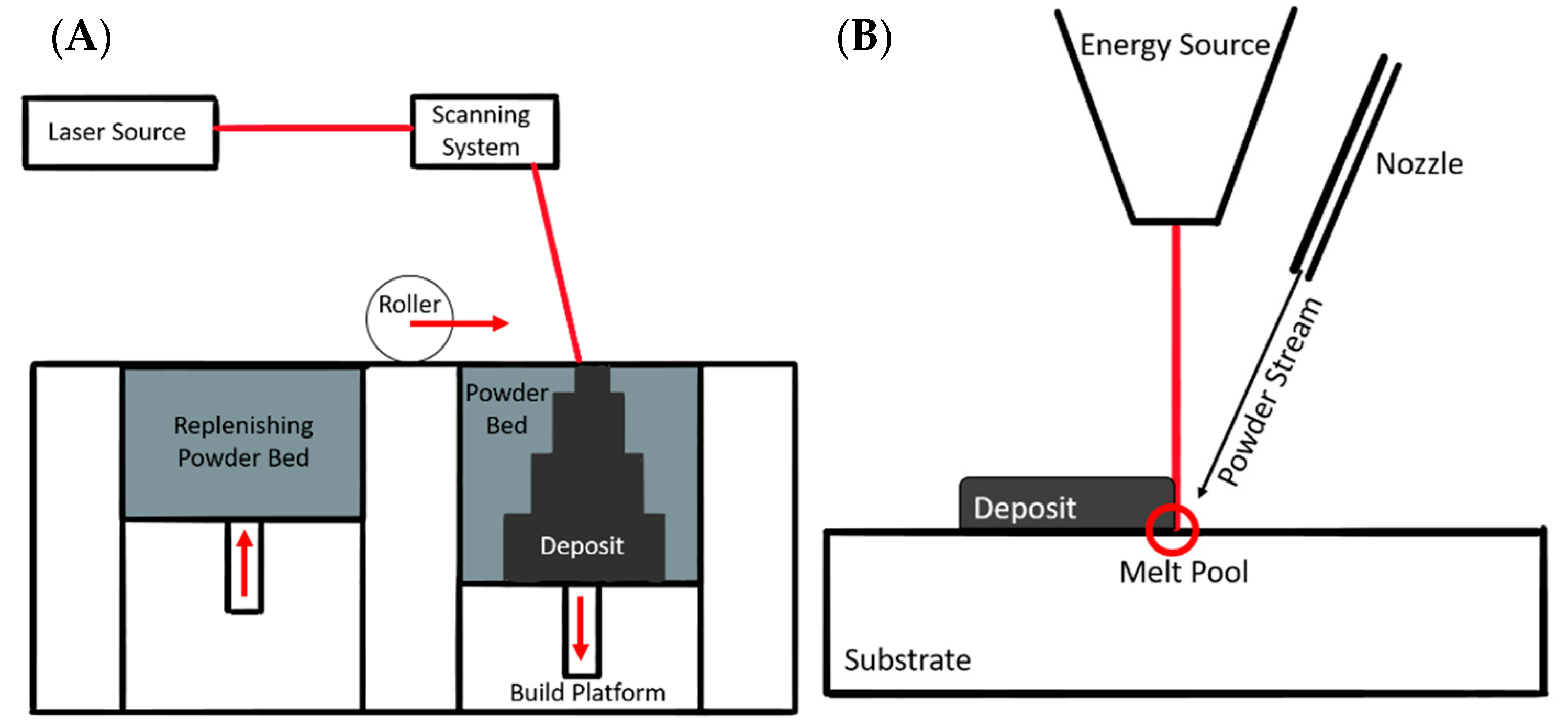



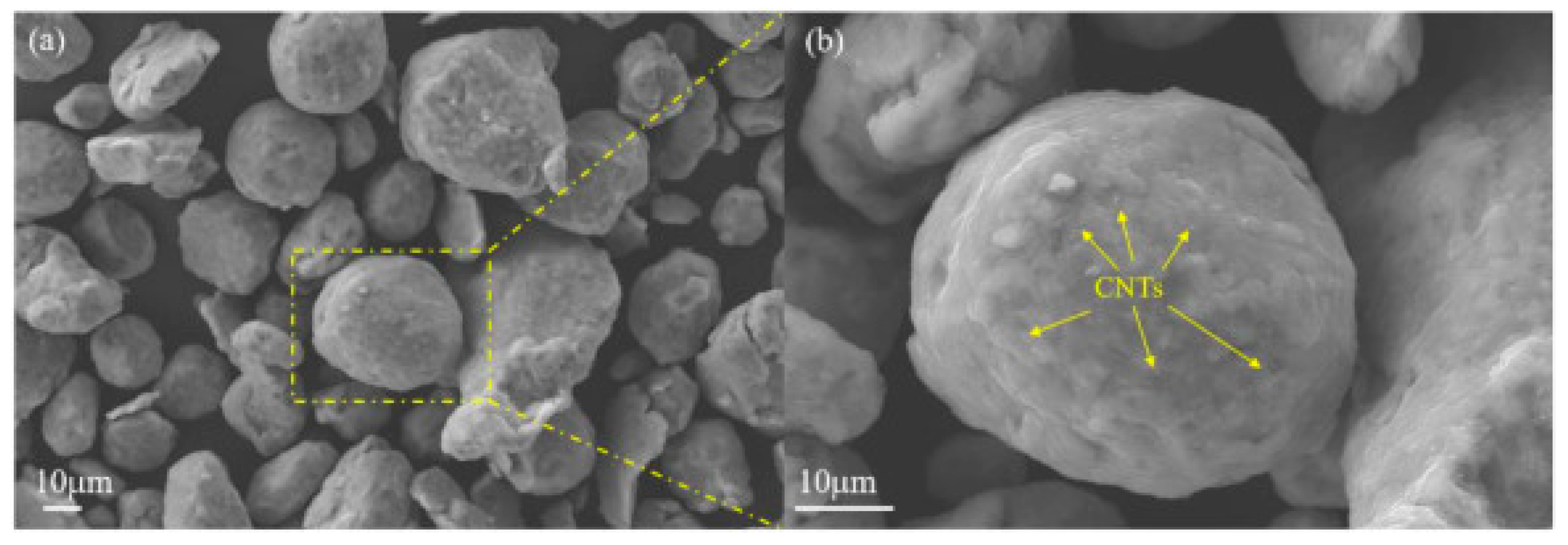

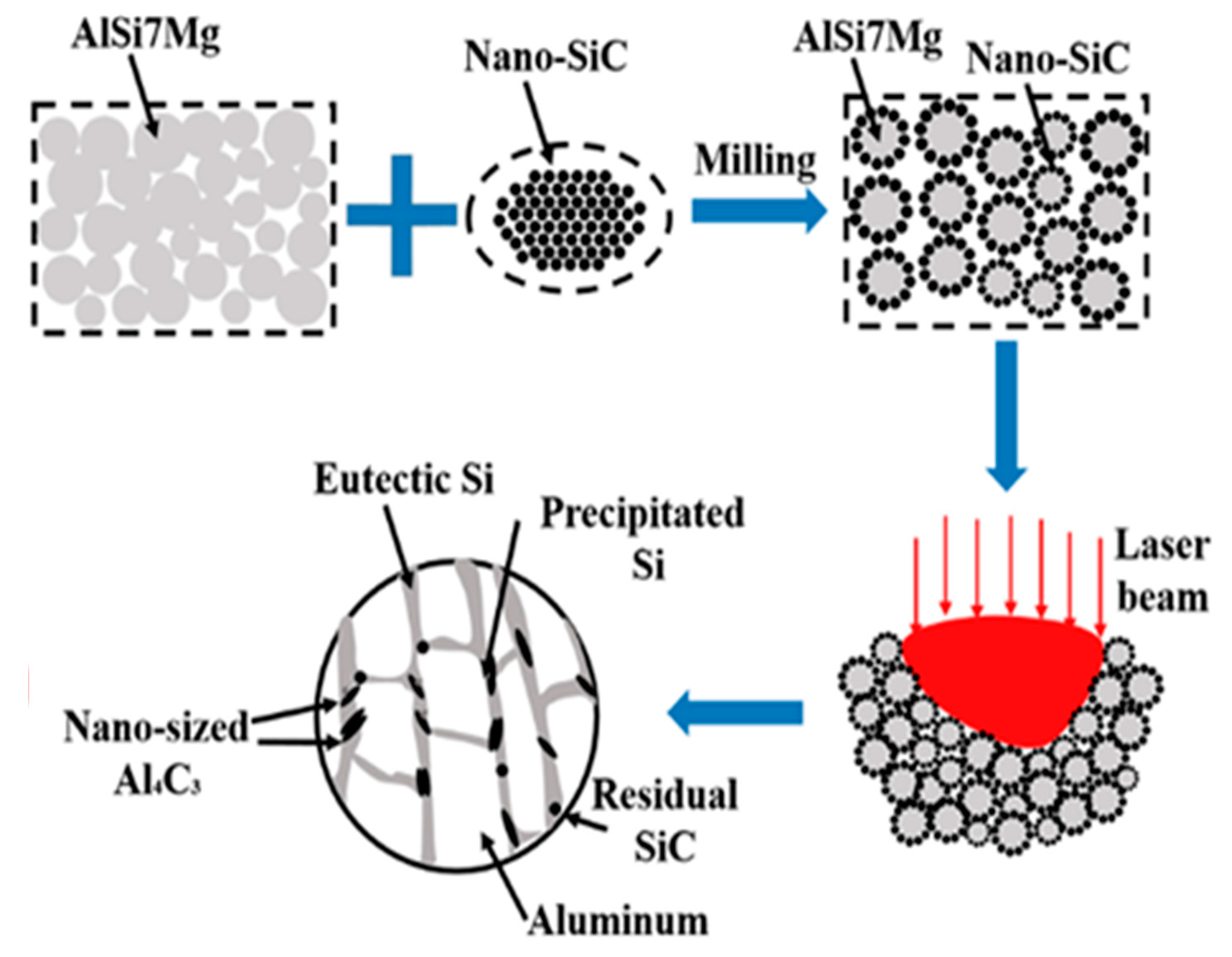
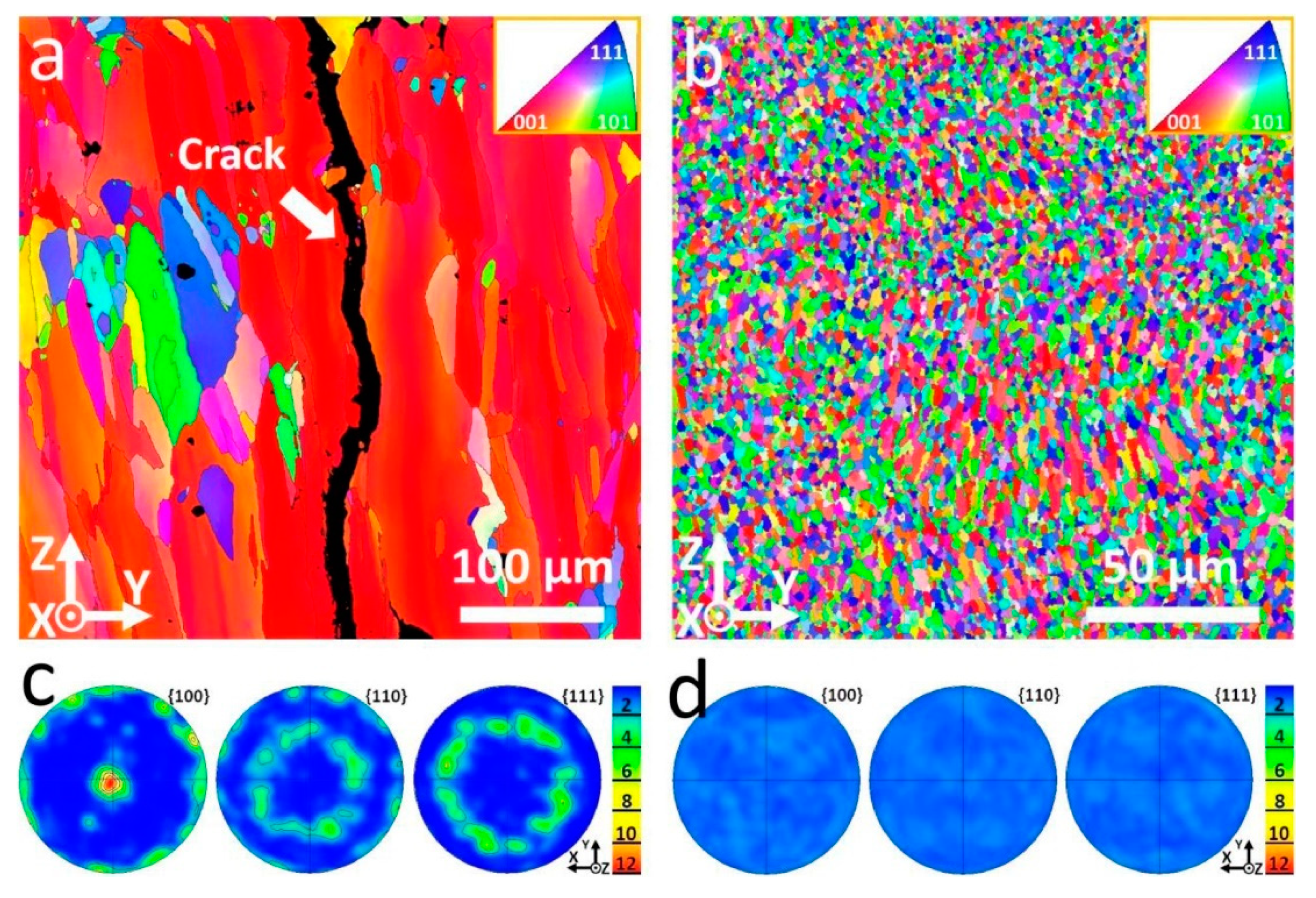
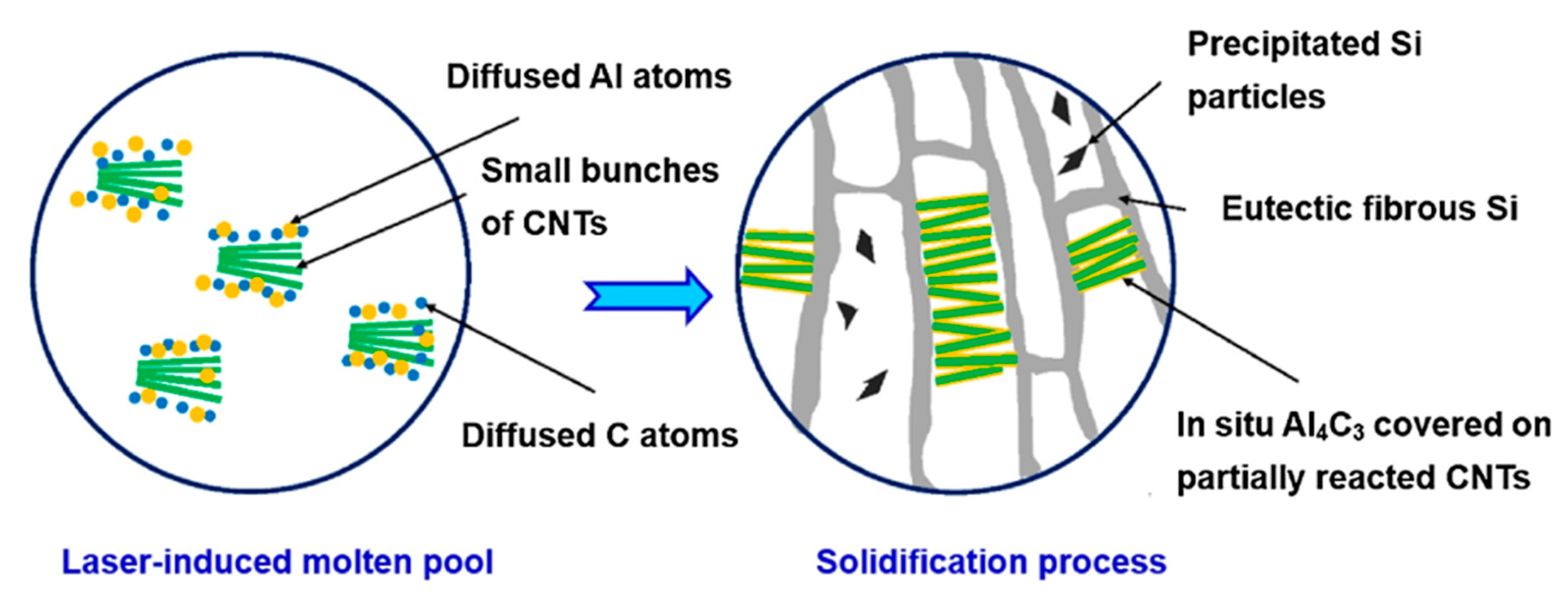
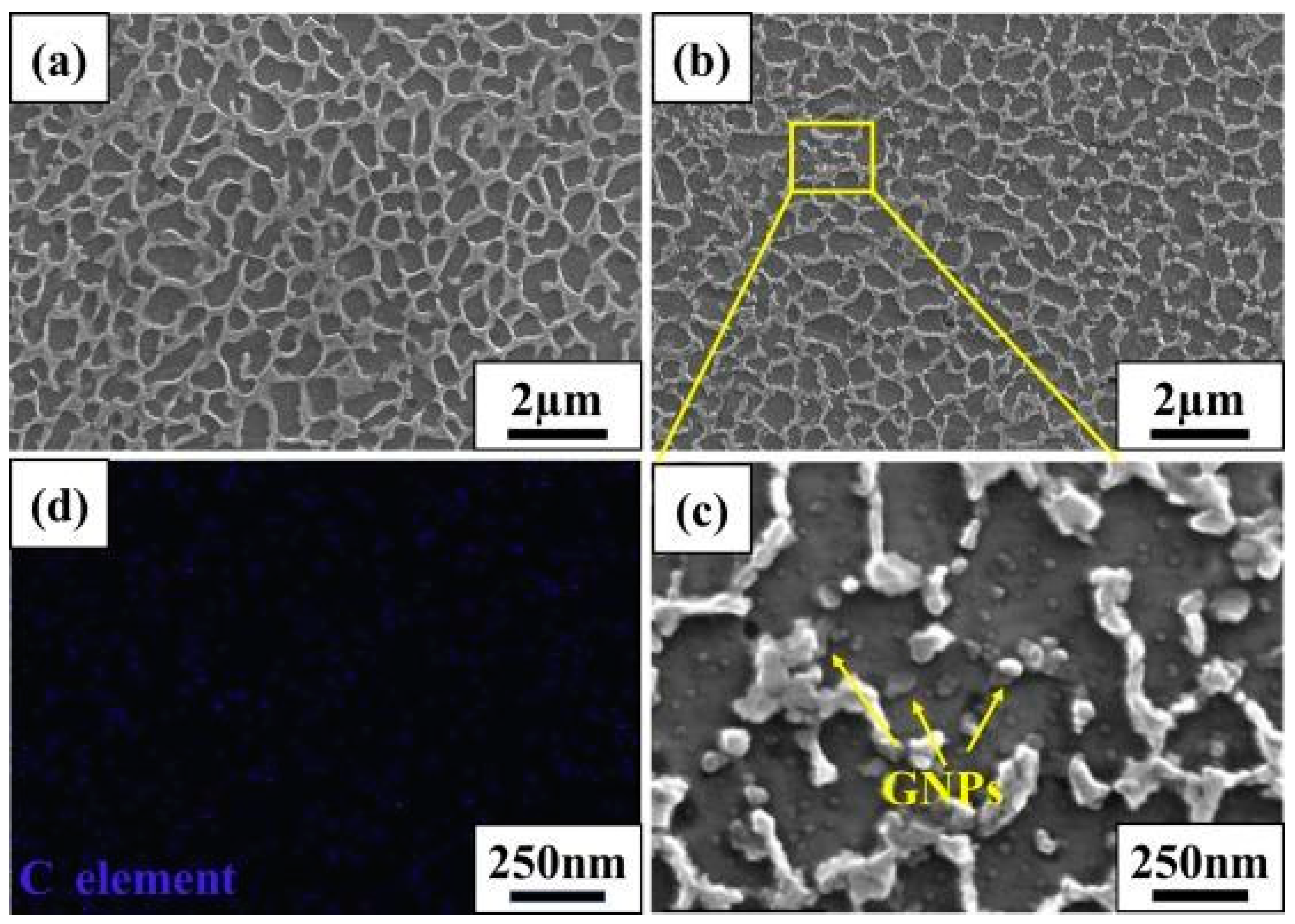
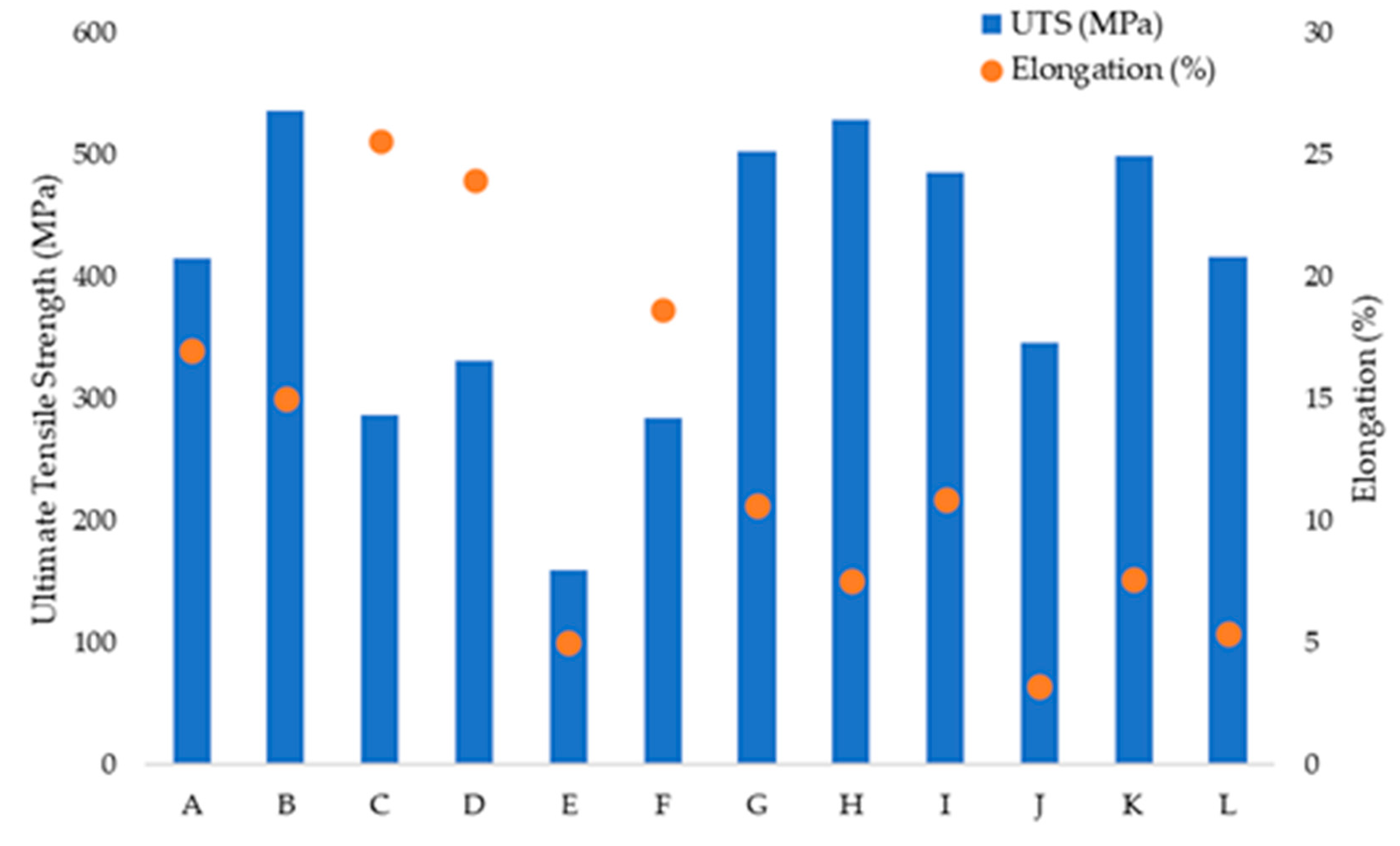
| A—Scalmalloy® [33] B—Scalmalloy®; 0° [34] C—ADDAlloy™ (1.18% Zr); 0° [35] D—ADDAlloy™ (1.57% Zr); 0° [35] E—4 vol% Al2O3/Aluminum [63] F—3 wt% TiB2/A2024 [48] | G—2 wt% SiC/AlSi7Mg [56] H—3.4 vol% TiB2/AlSi10Mg [52] I—3 wt% TiC/AlSi10Mg [59] J—0.5 wt% GNPs/AlSi10Mg [61] K—1 wt% CNT/AlSi10Mg [54] L—1 vol% ZrH2/A7075 [8] |
| Specification | Selective Laser Melting | Directed Energy Deposition |
|---|---|---|
| Energy Source | Laser Beam | Electron Beam, Laser Beam |
| Powder Size (μm) 1 | 15–45 [27] | 45–150 [28] |
| Surface Roughness | Minimal | High, often requiring post-processing |
| Reported Minimum Feature Size (μm) 2 | 40–200 [29] | 500–3000 [29] |
| Available Compositions | Wide range of compositions | Few compositions due to powder availability with desired characteristics |
| Part Repair | No, restricted to new parts | Yes, able to build upon existing structures |
| Material | Process | Direction | YS (MPa) | UTS (MPa) | Elongation (%) | Hardness | Source |
|---|---|---|---|---|---|---|---|
| Commercial Purity Al 1 | SLM | 38 HV | [39] | ||||
| SLM | Parallel | 90 | 110 | 30 | [40] | ||
| Perpendicular | 90 | 110 | 30 | ||||
| Al-xCu-yMg-zMn (x = 4.24, y = 1.97, z = 0.56 wt%) | SLM | 276 ± 41 | 402.4 ± 9.5 | 6 ± 1.4 | 111 HV | [22] | |
| AlSi7Mg0.3 1 | SLM | 200 | 400 | 12–17 | [41] | ||
| AlSi10Mg | SLM | Parallel | 334 | 3.64 | 102.2 HB | [42] | |
| Perpendicular | 358 | 7.4 | 103.2 HB | ||||
| SLM | 196 | 396.5 | Z: 90 HV XY: 115 HV | [43] | |||
| DED | 200 ± 10 | 344 ± 16 | 5 ± 1.0 | 107 ± 4 HV 2 | [44] | ||
| 6061 | SLM | 246.7 | 392 | Z: 67 HV XY: 84 HV | [43] | ||
| Al 7075 | SLM | Parallel | 203 ± 12 | 0.50 ± 0.2 | [9] | ||
| Perpendicular | 42 ± 7.5 | 0.51 ± 0.25 | |||||
| Scalmalloy® | SLM | Parallel | 280 ± 6.1 2 | 415 ± 14 2 | 14–17 2 | 110 ± 3 HB 3 | [33] |
| ScalmalloyRP0.66–4.5 1 | SLM | Parallel | 522 | 536 | 15 | 105 HV | [34] |
| 45° | 507 | 524 | 14.5 | ||||
| Perpendicular | 505 | 529 | 13 | ||||
| ADDAlloy™ (1.18 wt% Zr) | SLM | Parallel | 221 ± 1 | 287 ± 1 | 25.6 ± 0.8 | 875 MPa | [35] |
| Perpendicular | 220 ± 3 | 292 ± 2 | 29.0 ± 1.6 | ||||
| ADDAlloy™ (1.57 wt% Zr) | Parallel | 282 ± 8 | 332 ± 2 | 24.0 ± 1.0 | 961 MPa | ||
| Perpendicular | 290 ± 6 | 329 ± 3 | 25.2 ± 1.5 | ||||
| A356—F | Sand Cast | 82 | 158.6 | 6 | [45] | ||
| 443.0—F | 55.16 | 131 | 8 | 40 HB | |||
| 710.0—F | 137.9 | 220.6 | 2 | 60–90 HB | |||
| A360—F | Die Cast | 165 | 317 | 4 | 75 HB | ||
| 413.0—F | 144.79 | 296.48 | 3 | 80 HB | |||
| 518.0—F | 193 | 310.3 | 5 | 80 HB | |||
| 6061—O | Wrought | 55 | 124 | 25–30 | [46] | ||
| 6061—T4 | 145 | 241 | 22–25 | ||||
| 6061—T6 | 176 | 310 | 12–17 | ||||
| 7075—O | 103 | 228 | 17 | ||||
| 7075—T6 | 503 | 572 | 11 |
| Material | Process | Direction | UTS (MPa) | Elongation (%) | Hardness | Source |
|---|---|---|---|---|---|---|
| 4 vol% Al2O3/Aluminum | SLM | 160 | ~5 | 48.5 HV | [63] | |
| 0.5 wt% Graphene nanoplatelets/Aluminum | SLM | 47.1 HV | [39] | |||
| 1.0 wt% Graphene nanoplatelets/Aluminum | SLM | 49.6 HV | ||||
| 2.5 wt% Graphene nanoplatelets/Aluminum | SLM | 66.6 HV | ||||
| 3 wt% TiB2/A2024 | DED 1 | 284 | 18.7 | 108.5 HV | [48] | |
| 1 wt% Ti/A2024 | SLM | Transverse | 365 ± 15 | 12 ± 0.5 | [57] | |
| Longitudinal | 356 ± 6 | 12 ± 1.5 | ||||
| 2 wt% SiC/AlSi7Mg | 502.94 | 10.64 ± 1.06 | [56] | |||
| 3.4 vol% TiB2/AlSi10Mg | SLM | Parallel | 529.60 ± 4.58 | 7.53 ± 0.15 | [52] | |
| Perpendicular | 522.91 ± 3.59 | 8.68 ± 0.49 | ||||
| 7 vol% TiB2/AlSi10Mg | 530 ± 16 | 15.5 ± 1.2 | 191 ± 4 HV0.3 | [26] | ||
| 3 wt% TiC/AlSi10Mg | SLM | 486 | 10.9 | 188.3 HV01 | [59] | |
| 2 wt% TiN/AlSi10Mg | SLM | 145 HV0.1 | [64] | |||
| 0.5 wt% Graphene nanoplatelet/AlSi10Mg | SLM | 346 | 3.2 | [61] | ||
| 1 wt% Carbon Nanotubes/AlSi10Mg | SLM | 499 | 7.6 | 143.33 HV | [54] | |
| 0.5 wt% Carbon Nanotubes/AlSi10Mg | DED | 89.0 2 | 105.8 HV0.1 | [53] | ||
| 1 vol% ZrH2/A7075 (T6) | SLM | 383–417 | 3.8–5.4 | [8] |
Publisher’s Note: MDPI stays neutral with regard to jurisdictional claims in published maps and institutional affiliations. |
© 2021 by the authors. Licensee MDPI, Basel, Switzerland. This article is an open access article distributed under the terms and conditions of the Creative Commons Attribution (CC BY) license (https://creativecommons.org/licenses/by/4.0/).
Share and Cite
Boillat, R.; Isanaka, S.P.; Liou, F. The Effect of Nanostructures in Aluminum Alloys Processed Using Additive Manufacturing on Microstructural Evolution and Mechanical Performance Behavior. Crystals 2021, 11, 524. https://doi.org/10.3390/cryst11050524
Boillat R, Isanaka SP, Liou F. The Effect of Nanostructures in Aluminum Alloys Processed Using Additive Manufacturing on Microstructural Evolution and Mechanical Performance Behavior. Crystals. 2021; 11(5):524. https://doi.org/10.3390/cryst11050524
Chicago/Turabian StyleBoillat, Rachel, Sriram Praneeth Isanaka, and Frank Liou. 2021. "The Effect of Nanostructures in Aluminum Alloys Processed Using Additive Manufacturing on Microstructural Evolution and Mechanical Performance Behavior" Crystals 11, no. 5: 524. https://doi.org/10.3390/cryst11050524
APA StyleBoillat, R., Isanaka, S. P., & Liou, F. (2021). The Effect of Nanostructures in Aluminum Alloys Processed Using Additive Manufacturing on Microstructural Evolution and Mechanical Performance Behavior. Crystals, 11(5), 524. https://doi.org/10.3390/cryst11050524








